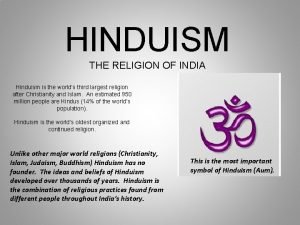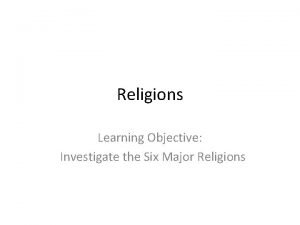Major Religions of the World Eastern Traditions Religions


- Slides: 2

Major Religions of the World – Eastern Traditions Religions name, number of followers, and symbol Origins & History Hinduism: 900 million Founder and founding unknown— indigenous religion in India; dominant religion throughout most of Indian history; involved heavily in Indian life/culture. Buddhism: Founded as the “middle path” by Siddhartha Gautama (Shakyamuni) in India around 480 BCE. Practiced most commonly in SE Theravada: (Thailand, Vietnam, etc. ) & Mahayana: East Asia (Japan, China) & Vajrayana: Tibet. 360 million Daoism: 394 million Founder of Daoism is traditionally Laozi. Started from early thoughts about, cheating death, balance, and the afterlife. Has been both embraced and persecuted throughout Chinese History. Both Classical and Folk schools. Relationship(s) to deitie(s) Holy texts: name and content Life’s overarching goal or purpose Thoughts on the afterlife Technically polytheistic, with many gods, but modern Hindus consider these to be manifestations of the same single god, making the religion monotheistic. Brahman is the manifestation of this one god. Ramayana; Bhagavad Gita (Mahabharata); Vedas, Upanishads, various sutras, etc. – mainly told via epic poem style stories with emphasis on doing ones duty (dharma). Follow one’s dharma (duty) while trapped in samsara (life cycle of life, death, and rebirth); goal is to eventually achieve moksha (release from the cycle) and return to Brahman. This takes many lifetimes, usually. Reincarnation. Some Hindus believe previous lives are the basis for the station one is born in to; others believe there is one chance to be human; other say the atman likes something new. Regardless one has roughly 383, 000 lives. Buddhists don’t care about deities, believing if they exist they are megalomaniacs because they do not help to end suffering. Bodhisattvas (living & reborn Buddhas) can achieve a god-like status. Pali Canon, Jataka Tales, Lotus Sutra, Tibetan Book of the Dead, Blue Cliff Record – all discuss how to end suffering and attachment, mostly through parables or koans. Daoism is polytheistic with the Yellow Emperor as the highest deity, though the manifestation of the Dao—which we cannot comprehend— is the Tai Di. Many other major, minor, and household gods/ancestors and immortals also exist. Dao De Jing, I Ching, writings of Zhuangzi and other works attributed to immortals. Classical Daoist texts generally use vague, infinitely interpretable poetry; Folk Daoist tend to have alchemy instructions and teach via parables. To achieve nirvana via building up good karma, releasing one’s self from all attachment and deep, personal meditation. Classical Daoism: Become one with nature/the way and be at peace though wu wei (limited, necessary action or inaction. ) Folk Daoism: Try to balance one’s qi with internal and external alchemy. Reincarnation. Karma (good and bad) determines what station in life one is reincarnated into. Reincarnation occurs until nirvana (i. e. buddhahood) is achieved. Originally everyone on inline with the Dao went to hell. That has softened. Both schools discuss a heaven in which actions on earth are paralleled in heaven. Heaven can interact with earth via rituals. Both believe in ancestor worship. Key rituals and practices Puja (ritual offering) can be given anywhere. Other key ceremonies (death, marriage) are done with a Brahmin priest, but location and time do not matter that much. Meditation, meditation. In some types—Nicheren & Vajrayana—of Buddhism, sutra chanting is also key. Other Buddhist rituals do exist. Thousands of various major or minor rituals in Daoism covering all aspects of life. Mostly done in a temple with a sage. Rituals generally involve a right of passage with the Gods or a key festival, like the Ghost Festival.

Major Religions of the World – Western Traditions Religions name, symbol, and number of followers Origins & History Relationship(s) to deitie(s) Founded by Abraham around 2000 BCE in the Middle East. Traditional religion of the Hebrew people. History of persecution and diaspora. Monotheistic allpowerful god named YHWH (Yahweh)—he is the god of everyone —who use to interfere in humanity but does not much anymore. Makes laws and issues commandments. Judaism: 14 million Christianity: 2 billion Islam: 1. 7 billion Founded by Peter and Paul based on the teachings of Jesus of Nazareth around 35 CE in the Middle East. Grows out of Judaism. Historically the main/only religion in Europe. Founded by Muhammad in 609 CE in Saudi Arabia. Grows out of Judaism and Christianity. Strongest roots (historical and modern) are in the Middle East and North Africa. Monotheistic all powerful, unnamed god (though some believe this is YHWH) who used to interfere in humanity but is relatively passive now. Much more benevolent than the god of the Old Testament. Monotheistic all powerful god named Allah. Islam literally means submission [to Allah]. Holy texts: name and content Tanakh (Old Testament) – and other stories of the Jews and their relationship with YHWH as well as some laws. Talmud – Jewish law and some scripture. Bible – most importantly the New Testament, which is the story of the early Christians. Further philosophy (Augustine of Hippo, Thomas Aquinas, etc. ) and papal/church doctrine and practice. Qur’an, which has never been altered from its original Arabic. Tells story of Islam through both laws and parables. Beliefs also come from the stories of the Bible. Life’s overarching goal or purpose Thoughts on the afterlife Serve God and obey mitzvoth (laws)—as many as possible. There are 613 total. Be a good person. (Judaism does not worry about beliefs as much as other religions. ) Historically not stressed. Some type of heaven/peace with YHWH has be expounded in recent years. Beliefs vary, a lot. Believe in the divinity of Jesus of Nazareth as the son of God and follow in his image to serve God—i. e. do good works. Belief in the Trinity and its loving power, Honor and worship Allah, do good works and follow the laws of Islam. Five Pillars: Shahada, Salat, Zakat, Sawm, and Hajj. And the Six articles of Faith. Teach others the will of Allah Key rituals and practices Rights of passage (i. e. circumcision, bar/bat mitzvah, etc. ) and traditional blessings (death, marriage, etc. ) are done when necessary. Sabbath and synagogue occurred from sundown Friday to sundown Saturday. Traditionally heaven and hell with heaven being the place where those believing in Jesus and at peace with God go, and Hell where everyone else is. Recent teaching on a benevolent god have dropped Hell as a physical place. Between 4 -7 sacraments (Eucharist, baptism, marriage, etc. ) of initiation, healing, and relationships. Weekly services in a church on the Sabbath (Sunday). Yearly holidays like Easter and Christmas. Very distinct heaven and hell. Good Muslims go to heaven and everyone else is in hell—at least for a little bit. Muhammad himself claims hell is not eternal Five pillars of Islam which govern the basics of any Muslim, along with rights of passage/life rituals. Prayers on Friday at the local Mosque. Prayer daily; also social customs: hijab, halal, etc.



